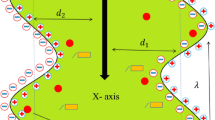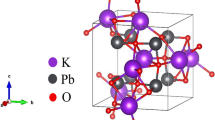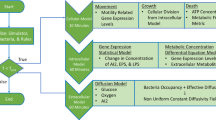Abstract
This article presents an efficient numerical approach to simulate the process of polarization and ion conduction in membranes of biological cells subjected to intense electric fields. The proposed method uses Coulomb’s law to calculate the electric field on the surface of the cell membrane and the continuity equation for calculating the difference in electric potential between the faces of the membrane. The behavior of the membrane conductance is described by a model of electroporation proposed in literature. This method provides results that agree well with the analytical model of polarization of an isolated cell suspended in electrolytic solution and also provides results for the conductance of the membrane during electroporation of cells in concentrated suspensions that agree with experimental results already published.







Similar content being viewed by others
References
Barnet A, Weaver JC (1991) Electroporation: a unified, quantitative theory of reversible electrical breakdown and mechanical rupture in artificial planar bilayer membranes. Bioelectrochemistry 25:163–182
Chen C, Smye SW, Robinson MP, Evans JA (2006) Membrane electroporation theories: a review. Med Biol Eng Comput 44:5–14
DeBruin KA, Krassowska W (1998) Electroporation and shock-induced transmembrane potential in cardiac fiber during defibrillation strength shocks. Ann Biomed Eng 26:584–596
DeBruin KA, Krassowska W (1999) Modeling electroporation in a single cell. I. Effects of field strength and rest potential. Biophys J 77:1213–1224
DeBruin KA, Krassowska W (1999) Modeling electroporation in a single cell. II. Effects of ionic concentration. Biophys J 77:1225–1233
Fricked H (1953) The electric permittivity of a dilute suspension of membrane covered ellipsoids. J Appl Phys 24:644–646
Gehl J (2003) Electroporation, theory and methods, perspectives for drug delivery, gene therapy and research. Acta Physiol Scand 177:437–447
Glaser RW, Leikin SL, Chernomordik LV, Pastushenko VF, Sokirko AI (1988) Reversible electrical breakdown of lipid bilayers: formation and evolution of pores. Biochim Biophys Acta 940:275–287
Gowrishankar TR, Weaver JC (2003) An approach to electric modeling of single and multiple cells. PNAS 100(6):3203–3208
Hibino M, Masaya S, Itoh H, Nagayama K, Kinosita K (1991) Membrane conductance of an electroporated cell analyzed by sub-microsecond imaging of transmembrane potential. Biophys J 58:209–220
Kinosita K, Tsong TY (1979) Voltage-induced conductance in human erythrocyte. Biochim Biophys Acta 554:479–497
Mali B, Jarm T, Corovic S, Paulin-Kosir MS, Cemazar M, Sersa G, Miklavcic D (2008) The effect of electroporation pulses on functioning of the heart. Med Biol Eng Comput 46:745–757
Miklavčič D, Puc M (2006) Electroporation. In: Akay M (ed) Wiley encyclopedia of biomedical engineering. Wiley, New York, pp 1–10
Mir LM (2001) Therapeutic perspectives of in vivo electropermeabilization. Bioelectrochemistry 53:1–10
Miklavcic D, Kotnik T (2004) Electroporation for electrochemotherapy and gene therapy. In: Rosch PJ, Markov MS (eds) Bioelectromagnetic medicine. Marcel Dekker, New York, pp 637–656
Nickoloff JA (1995) Animal cell electroporation and electrofusion protocols, 1st edn. Humana Press Inc., New Jersey
Nikolski VP, Efimov IR (2005) Electroporation of the heart. Europeace 7:46–154
Pavlin M, Slivnik T, Miklavčič D (2002) Effective conductivity of cell suspensions. IEEE Trans Biomed Eng 49:77–80
Pavlin M, Pavselj N, Miklavčič D (2002) Dependence of induced transmembrane potential on cell density, arrangement, and cell position inside a cell system. IEEE Trans Biomed Eng 49:605–612
Pavlin M, Kandušer M, Reberšek M, Pucihar G, Hart FX, Magjarević R, Miklavčič D (2005) Effect of cell electroporation on the conductivity of a cell suspension. Biophys J 88:4378–4390
Ramos A, Suzuki DOH, Marques JLB (2006) Numerical study of the electrical conductivity and polarization in a suspension of spherical cells. Bioelectrochemistry 68:213–217
Sersa G, Miklavčič D, Cemazar M, Rudolf Z, Puchihar G, Snoj M (2008) Electrochemotherapy in treatment of tumours. Eur J Surg Oncol 34:232–240
Weaver JC, Chizmadzhev YA (1996) Theory of electroporation: a review. Bioelectrochemistry 41:135–160
Author information
Authors and Affiliations
Corresponding author
Rights and permissions
About this article
Cite this article
Ramos, A. Improved numerical approach for electrical modeling of biological cell clusters. Med Biol Eng Comput 48, 311–319 (2010). https://doi.org/10.1007/s11517-010-0591-4
Received:
Accepted:
Published:
Issue Date:
DOI: https://doi.org/10.1007/s11517-010-0591-4




